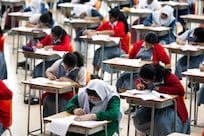When asked which animals symbolise China and India, most people would probably say the dragon and the elephant. In terms of long-term economic prospects, however, the hare and the tortoise may well turn out to be a more appropriate choice.
While India is moving more slowly than China at this point, there is a real possibility that over the next decades we may not only see it catching up, but even pulling ahead. With the exception of some patriotic Indians, most people will find this point surprising, if not far-fetched.
Certainly, on its past and present form and record, China has been winning the contest hands down. Adjusted for differences in purchasing power, China's total GDP in 2008, the latest year for which confirmed World Bank statistics are available, was more than twice that of India. If we standardise by population, India narrows the gap, but China's per capita GDP of US$6,000 (Dh22,038) is still about twice that of India.
This is even more remarkable given that China's per capita GDP in 1978, the year Chinese economic reforms began, was just slightly more than half that of India. Absolute poverty rates in China, which were one third higher than India's in 1981, are now half those of India.
And despite Indian economic reforms from 1991, the output gap has been growing further. Between 2004 and 2008, China's economy grew at an average annual rate of 10.8 per cent, compared with 8.7 per cent for India.
There are good reasons for China's ability to pull so far ahead of India. One centres on economic fundamentals. Scholars usually attribute economic growth in the early stages of development mostly to mobilisation of capital and of labour into productive processes.
There is obviously no shortage of capital for large Chinese companies today but even in the early 2000s China's real interest rates for listed companies were less than half those paid by their Indian counterparts. China also continues to attract vastly more foreign direct investment, by a factor of 2.5, though India has been catching up in this area.
Yet mobilising capital is the easy part. Building up a good basis of human capital is harder, and here India has been severely handicapped. Labour regulations in India have prevented the mass mobilisation of people into industry.
And even basic skills are often missing. Average illiteracy rates in India are about 40 per cent, compared with less than 10 per cent in China. Among the young, China is achieving almost universal literacy; India's education system still fails to reach about a quarter of this.
Underlying these differential developments are variations in the roles played by the state. The World Bank ranks India 133rd out of 183 economies in terms of ease of doing business, while China is placed at 89th. In fact, Indian businesses tend to succeed where they can evade state rules and regulations.
India's comparative advantage in services such as business process outsourcing can, in good part, be explained by two factors. First, the state never got around to regulating it. And second, unlike for manufactured products, the export of these services is not hamstrung by bad roads and lengthy customs procedures; as long as the data and phone lines are operational, business can proceed.
In short, China looks like the sure winner. But so did the hare, and the tortoise beat him. China is not going to fall asleep by the wayside, as did the hare in Aesop's fable. But a number of developments may conspire to allow India to catch up to and, in the long run, perhaps even surpass China.
One of these developments is demographic change. As a consequence of its one-child policy, China is set to undergo demographic ageing so rapidly it may grow old before it grows truly rich. In 20 years, China's percentage of old people is likely to reach about the same level as that of the more developed countries today.
This raises the question of how to devise social security and medical systems to take care of the elderly. It also means that the proportion of young, and typically highly productive, workers is falling fairly rapidly. Abolishing the one-child policy might reduce the scope of the problem but it will not eliminate it.
India does not face this problem, although it remains to be seen whether government policies will adjust sufficiently for the country to be able to take advantage of this "demographic dividend".
A second point pertains to the finding that high economic performance requires good institutions, or ways of running and doing things. As it turns out, the real challenge in economic development is not getting to a per capita GDP of $3,000, or $6,000, or even $10,000. Rather, economies tend to hit a wall once they reach about $15,000 per capita. China is likely to reach this barrier in about 2020, while India will probably take about a decade longer.
It is hard to predict which of them, if either, will succeed in scaling this wall of institutions. As the examples of Hong Kong and Singapore suggest, western-style democracy does not seem to be a necessary condition, so China is not necessarily at a disadvantage.
At the same time, it has only about 10 years left to start approximating conditions in these two places. India, by contrast, has the luxury of a 20-year reform period, although success is contingent on whether its political system will make the most of this opportunity.
A third, and perhaps decisive, factor concerns geopolitics. Here most models of international relations point to the same conclusion: China is heading for a period of increasing conflict and rivalry with the US. The so-called realist school frets that the change in the balance of power between the nations is likely to lead to conflict.
The liberal school points to numerous disagreements, ranging from economic frictions about trade and exchange rates to matters such as Tibet, Taiwan and human rights, on which constituents on both sides maintain different views.
The institutionalist school of thought would hope that the World Trade Organisation, the UN and other bodies can keep these tensions in check. At the same time, neither nation has a spotless record in terms of compliance with international institutions.
Even so, India's tortoise might yet better the Chinese hare.
Michael Witt is an affiliate professor of Asian business and comparative management at INSEAD business school





